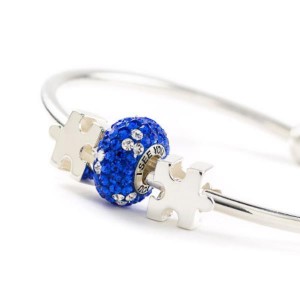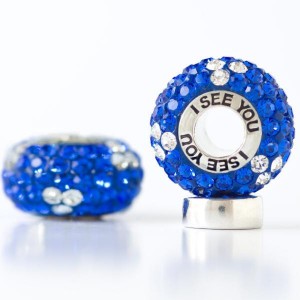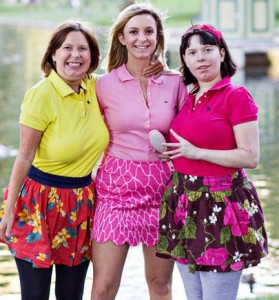As mentioned in a previous blog post, the U.S. Department of Health and Human Services now estimates roughly 1 in 50 school-aged children are diagnosed with Autism Spectrum Disorder (ASD). This estimated increase in ASD prevalence suggests that steps are being taken to improve diagnosis of the disorder. ASD is not generally diagnosed until after three years of age, yet a recent study published in the American Journal Psychiatry examined the possibility of diagnosing ASD in children as young as seven months old.
This study included fifty-seven “high-risk” infants with an older sibling diagnosed with ASD and forty “low-risk” infants with typically developing older siblings. The infants participated in the study at seven months old and returned for a clinical assessment after their second birthday. This assessment determined which of these children should be diagnosed with ASD. Knowledge of their diagnosis was then used to analyze the study’s data.
The study measured the brain activity and amount of time required for a seven month old infant to shift their gaze during a visual attention task. Researchers compared the eye movements and visual attention of infants later diagnosed with ASDs, to those of a typically developing infant of the same age.

To do so, researchers engaged infants in the Gap/Overlap Task. During the Gap Task, infants sat on their parent’s laps and watched images appear on a monitor. The first image appeared in the center of the screen, attracted the infant’s gaze, and then disappeared. A gap of time passed before a second image appeared on the edge of the screen. Advanced eye tracking equipment captured the infant’s eye movements. These measurements provided researchers with the exact timing of the shift in gaze.
The Overlap Task measured eye-movements as well, but also included a measure of brain activity. During this portion, the image remained in the center of the screen, while a second image appeared at the edge. Eye tracking equipment measured the time it took infants to shift their gaze to the peripheral image. Using functional Magnetic Resonance Imaging (fMRI), the researchers also measured the amount of processing occurring in different regions, in the infant’s brain to determine if there were patterns that distinguished the two groups.
Results showed a difference of 25 to 50 milliseconds on average between infants later diagnosed with ASD and their typically developing counterparts. Researchers believe this delay can be accounted for by differences in the developing neurological circuits of a child’s brain. During this period of early infancy, the brain’s pathways for communication are forming quickly. These pathways influence how the infant interprets and responds to the environment.
Researchers identified the splenium of the corpus callosum as one such pathway that may be related to the difference in gaze shifting. This structure is an important neural connection between the brain’s left and right hemisphere. Results revealed a correlation between large splenium size and the speed with which infants shift their gaze. The ability of an infant to rapidly switch gazes improved with increased size of the splenium in typically developing infants.
However, researchers found no similar correlation in infants later diagnosed with ASD.
Although 25 milliseconds seems brief, this delayed reaction time implies a possible overall difference in the way the infant’s brain is developing. A small delay at this early stage may hint at larger differences in cognitive and social development. Thus, this attention shifting delay may well serve as a precursor to other well-known symptoms of autism. Such symptoms including difficulty making eye contact and coordinating gaze. Research consistently suggests an association between autism and deficits in pursuit eye movement. Further gaze testing research may allow professionals the opportunity to predict the development of these symptoms as opposed for waiting for them to occur.
By detecting neurological differences through research on subtle delays at the infant stage of development, researchers hope to improve ASD diagnosis at an earlier age. Earlier diagnosis will help parents to recognize their infant’s needs and begin working to help their child reach his or her full potential. These potential diagnostic tools such as fMRI might be useful longitudinally as well to chart an individual’s progress during early intervention therapies.
To read more about this study, check out the full article.
Citations:
NIH/National Institute of Child Health and Human D. “Gaze Shifting Delay Has Potential To Diagnose Autism At 7 Months.” Medical News Today. MediLexicon, Intl., 27 Mar. 2013. Web. <http://www.medicalnewstoday.com/releases/258189.php>
Takarae, Y., Minshew, N., Luna, B., Krisky, C. & Sweeney, J. Pursuit Eye Movement Deficits in Autism. Brain: A Journal of Neurology 127, 2584–2594 (2004).








 She has not asked for him since, but found a Batman mask given to her by the boys on our trip home. Lilly had regressed on that trip — humming constantly, little to no language, wandering — and the only thing that seemed to calm her was the mask. It acted as a comfort, an escape: heartbreaking and adorable wrapped in the same breath.
She has not asked for him since, but found a Batman mask given to her by the boys on our trip home. Lilly had regressed on that trip — humming constantly, little to no language, wandering — and the only thing that seemed to calm her was the mask. It acted as a comfort, an escape: heartbreaking and adorable wrapped in the same breath.
 As an older sister to two incredible, beautiful, amazing girls with autism, I am extremely grateful for the amount of support from donors that help keep The Autism Research Foundation running. Since I was able to speak and to think on my own, I’ve known that my most important role in life would be to be my sisters’ voice.
As an older sister to two incredible, beautiful, amazing girls with autism, I am extremely grateful for the amount of support from donors that help keep The Autism Research Foundation running. Since I was able to speak and to think on my own, I’ve known that my most important role in life would be to be my sisters’ voice.



